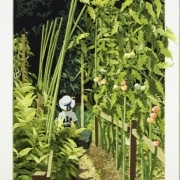
- This event has passed.
Exhibition: Harie by Junko Yamada
September 10日, 2011 - January 4日, 2012

The CRS Gallery announces a solo exhibition by Junko Yamada of art works composed of thousands of pieces of rice paper in the tradition of harie. The exhibition will be on view from November 4, 2011 – January 4, 2012.
By applying modern subject matter and lively colors to a traditional Japanese art form, Junko creates unique works of art on rice paper. These collages are each composed of thousands of pieces of rice paper in the tradition of harie, a style of Japanese art.
“Japanese artists have been using unique, strong papers for centuries, since the Nara period. The Japanese value paper in their art and use it in their daily lives, as evidenced by their furniture and interior design. When working with rice paper, the tools that I and other artists employ are the X-acto knife, Yamato glue, rollers, two-sided tape, tweezers, safety pins, tracing paper, drawing pad, and scissors.”
Junko Yamada was born in Kyoto, Japan. Growing up in the beach resort area of Miyazu, a beautiful area of Japan located on the Pacific coast about two hours north of Kyoto, she was influenced in her art by the spectacular scenery. Her academic training includes the Art Institute of Boston (1986-1988) and the Art Institute of Alexandria, Virginia (1992-2000). It was in Boston that she realized how the natural beauty of the Japanese seashore is reflected in her vibrant colors and cheerful style. She hopes that, like the ocean and the mountains of my childhood in Kyoto, her work instills a sense of tranquility and inner peace, a visual escape from everyday life.
Introduction to Japanese Rice Paper
Many people consider Japanese culture as a culture of wood and paper. We consider Western culture as a culture of stone and soil. The Japanese have been using paper since the Nara period (710-793). Unfortunately, Japanese paper can not be preserved as easily as stone or soil and is therefore more transient. We Japanese view papers as an important part of our culture, and find ways to integrate it into our daily lives by creating our unique small galaxy of beautiful things using paper. The Fusuma (sliding door), Byobu (screen), Andon (lamp), and Shoji (screen door) are examples of these. Japanese paper also contributes to the roots of other Japanese art such as: Sui-boku-ga (Japanese ink drawing); Sho (calligraphy), and wood cut print.
Junko’s Artistic Concept
Junko endeavors to introduce and share aspects of Japanese life and culture through her works. She tries to work in a happy and cheerful mood. Working in great detail, she typically uses thousands of small pieces from a wide variety of papers to complete each art piece.
During her stay Japan from 1988-1991 and in subsequent visits Junko does extensive shopping for rare and hard-to-find paper throughout Japan. Additionally, her friends in Japan occasionally send her batches of assorted sheets of paper. In recent years, the selection of papers now available in the U.S. has seen a dramatic increase, much to her delight. Working primarily from individual or a series of photographs as her subject, Junko uses an X-acto knife, Yamato glue (from Japan), rollers, two-sided tape, tweezers, pins, tracing paper, pencil, drawing pad, a cutting pad, and of course many types of paper to complete her works. Her subjects include Japanese and American landscapes and scenery, as well portrait and abstract works. Most of her works are in multi-color, while some portraits are in monochrome.